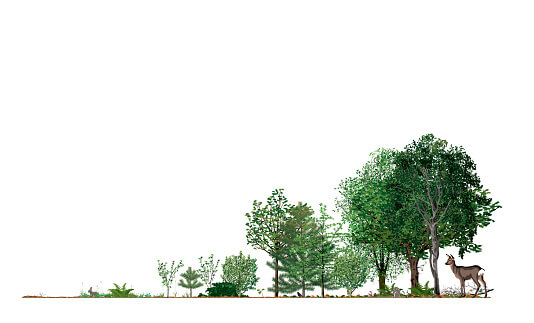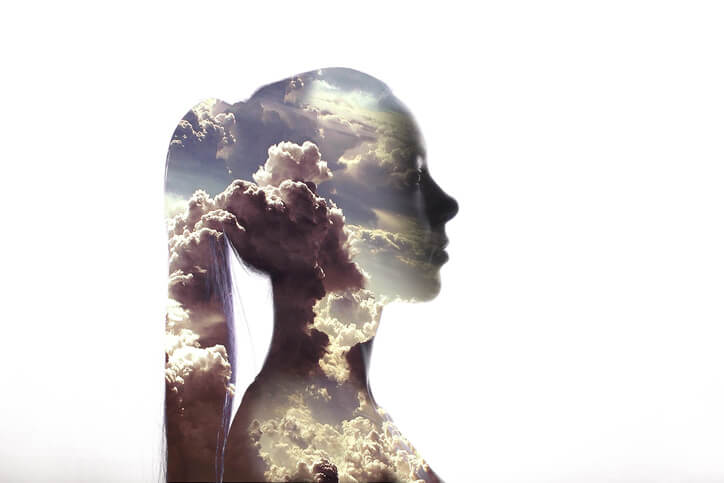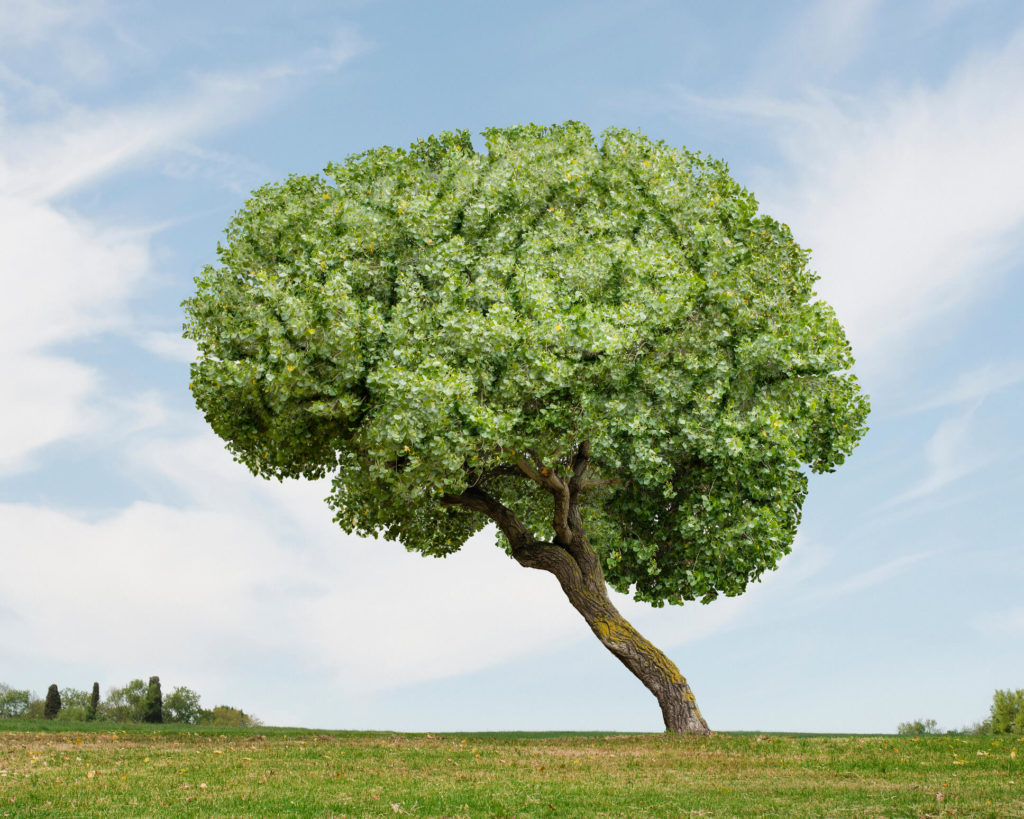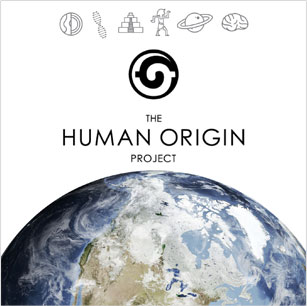On earth, trillions of organisms have evolved traits to ensure their survival.
None is more mysterious than consciousness.
The brain and neural system is a highly adapted tool that helps organisms interact with the environment. The laws of evolution tell us that traits are adapted to increase the chances of survival of a creature.
Of traits found over the planet, consciousness, is rarely studied in the context of evolution. Human evolution is heavily centered around how our brain enlarged and expanded its function. The origin and very nature of consciousness is a mystery that scientists are yet to truly understand.
In this article, we’ll explore the evolution of consciousness, the human brain, and its associated traits.
When did consciousness first appear?
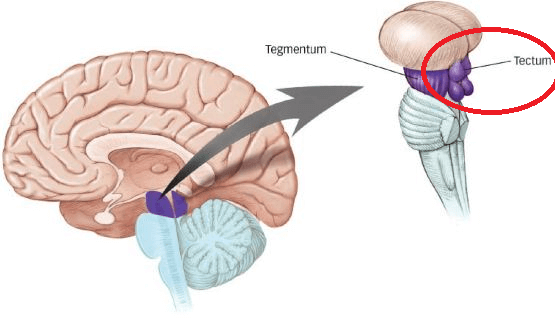
Is the tectum the source of the evolution of consciousness?
Consciousness is thought to have evolved during the Cambrian Explosion. This is when vertebrates were tiny wriggling creatures competing with a vast range of invertebrates in the sea.
Fossil and genetic evidence reveal vertebrates evolved around 520 million years ago. Vertebrates are unique from invertebrates due to the presence of a skeleton. The spine or skeletal system is necessary to house a complex immune neural system.
In all vertebrates, the forebrain vesicle initially forms a simple hollow tube. It’s the presence of the tectum that separates vertebrates from invertebrates.
All vertebrates—fish, reptiles, birds, and mammals—have a tectum. Even lampreys have one, which is an ancient, jawless fish.
“Tectum” means “roof” in Latin, and it often covers the top of the brain.
It acts as a central controller for attention that coordinates sensory input. Also, it organizes something called overt attention. That helps a creature to aim the satellite dishes of the eyes, ears, and nose toward anything important. It then combines this information together as ‘attention’ to the environment.
The tectum allowed vertebrates to develop complex neural systems. That then assisted in the evolution of a ‘conscious’ neural system.
How has the brain changed over time?
As creatures evolve, brain complexity increases. Evolution has changed the shape and function of the brain.
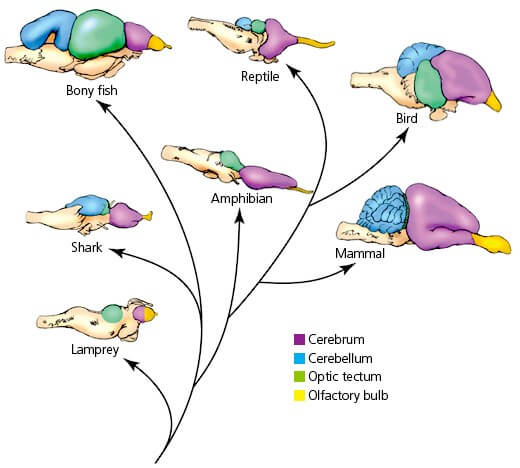
The reptilian brain compared to mammals lack the outer cerebral cortex. Source
Brains seem to evolve in three ways:
The evolution of consciousness is related to ways that brains become more complex in nature.
1) Increase in brain size
The relationship between brain size and body size is highly ordered. In most vertebrates, brain size varies approximately 10-fold. Brain size increases with body size, although this increase is not proportional.
Both birds and mammals have brains that are 6–10 times larger than the brains of reptiles of the same body size.
2) Increase in neural centers
An increase in neural centers with an increase in relative brain size allows new functional areas of the brain.
As brains increase their neural centers, they are able to process and transfer far more information.
It’s best illustrated in the forebrain, particularly the cerebral hemispheres.
3) Increase in cell classes
There are more cell classes in the cerebral cortex of a mammal than in the entire neural system of a lamprey. The brain centers where cells classes can be measured with data to include: the cerebellum, the olfactory bulb, and the optic tectum.
Brains use different tools as they evolve and become more complex.
What part of the brain evolved last?

Three evolutionary divisions of the human brain. Human consciousness can be attributed to higher centers in the neocortex.
The neocortex or six-layer cortex appears to be a distinguishing feature of mammals. It is involved in higher functions that are attributed to ‘consciousness.’ These include sensory perception, generation of motor commands, spatial reasoning, conscious thought, and language.
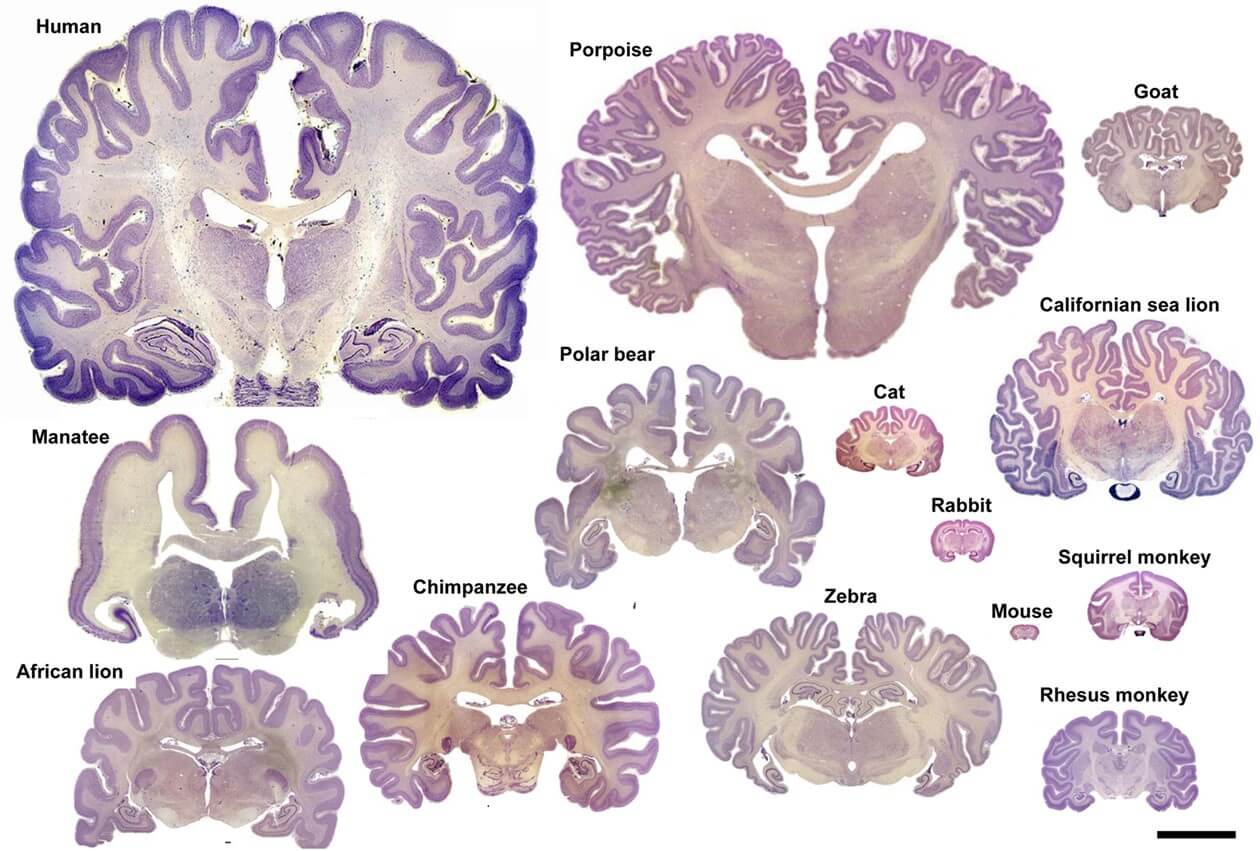
Variability of brain size and in different animal species. Source
If we look at the human body, the brain is he in relation. According to our body mass, it should be six times smaller than it is. Being this big, it also eats almost 20% of the energy of our body.
Brains also get larger when there is more mental demand. As brains get more complex, stronger mental demand also fuels further growth.
The human brain has a larger and far more expanded neocortex than primate ancestors. As the human brain evolved, it increased in volume from roughly 400cm3 to 1500cm3.
At 1.8 million years ago, Homo erectus was able to create the first bifacial tools. It was a measure of cognitive ability above Australopithecus.
Homo heidelbergensis, existed 650,000 years ago and had a larger brain (cranial capacity of 1,350 cm3) than Homo erectus (brain volume between 800 and 1,200 cm3)
However, it doesn’t hold true for all measures of brain function.
Studies have looked at whether the brains of people with higher intellectual abilities are bigger or different in any way. The results showed that for history’s greatest thinkers, there appeared to be no anatomic pattern or brain size of ‘intelligence.’
What does it mean to be conscious?
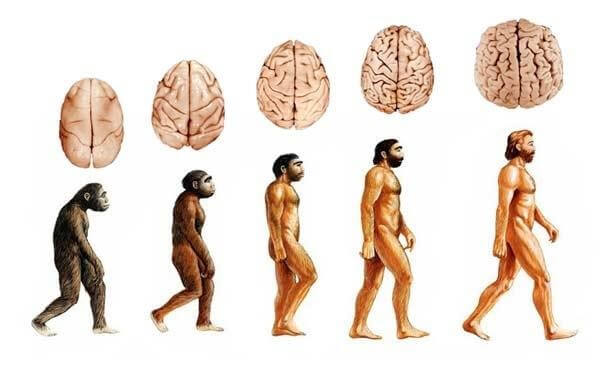
Human evolution from primates included a tripling in brain volume mainly in the cerebral cortex.
One question scientists are grappling with is how to classify a creature as conscious or not.
Consciousness is a difficult trait to define. Some characteristics line up with what we consider a creature ‘conscious’ or not.
Awareness and wakefulness represent the two main components of consciousness. It’s a state defined by the content of consciousness, and arousal is defined by the level of consciousness.
Awareness contains self-awareness, which perceives the internal world of thoughts, reflection, imagination, emotions, and daydreaming. There is also external awareness, which sees the outside world with the help of the five senses.
It’s known that non-human animals have the substrates of conscious states. They can also exhibit intentional behaviors. The weight of evidence indicates that human neural systems are not unique in generating consciousness.
Non-human animals classed to have evolved consciousness include all mammals and birds, and many other creatures. These include octopuses who possess intelligent neural systems.
Evolved consciousness may be attributed to nonhuman primates, social carnivores, cetaceans, rodents, and birds.
How has the human brain evolved?
Beyond wakefulness and awareness, certain human traits have evolved in the path of consciousness.
1) The evolution of language
Nearly all creatures have language and communication. Human brains, however, have developed areas equipped for complex language. It is perhaps the most recent and big leap in the evolution of consciousness.
It’s unknown when human language first evolved. We know that it was present 70 thousand years ago. This was when it’s thought that people began to disperse around the world. Language began to diversify and spread to the vast amount that we see today.
The relationship between language and consciousness is often debated. One big advance for humans is that when complex language developed. From then, consciousness could be discussed and compared amongst other people.
2) The evolution of intelligence
Consciousness is often associated with intelligence. There is no universally accepted definition of intelligence. One is “the ability to reason, plan, solve problems, think abstractly, comprehend ideas and language, and learn.”
However, intelligence can be argued to have evolved independently among the animal kingdom. In evolutionary terms, it’s named convergent evolution. Intelligence and consciousness are measured in birds, dolphins, and other mammals.
Intelligence is found in environmental, spatial learning, and foraging strategies in insects. It’s also used for social learning in certain fish and remarkable in spatial orientation and navigation in birds.
For humans, the evolution of hominid intelligence can be traced for the past 10 million years. It’s thought specific environment changes allowed the perfect learning environments in primates.
The situation a brain is placed in does seem to matter. For example, not all primates evolve higher intelligence. There are primate species which have not evolved any greater degree of intelligence than they had 10 million years ago. It’s thought that their particular environment has not demanded this specific adaptation of them.
Amongst primates, high general intelligence has independently evolved at least four times. These include in capuchins, baboons, macaques, and great apes.
It’s unknown exactly why intelligence seems to develop in some species, and not others.
3) The evolution of morality and conscience
The idea of right and wrong is something that mainly exists within human consciousness. Humans bring together sensations, thoughts, and intentions, which feed to an inner judgment process.
Science has struggled to measure these tools of consciousness. It is improbable that science would ever be able to explain why there are brain events that equate to ‘morality’ or a conscience.
Regarding the timeline of evolution, conscience develops much later. It’s the logical combination of morals and ethics that guide thought process and action. Conscience is not a feeling or an emotion, more like an inner choice which reflects a value system.
Morality does evolve with cultural experience. For example, by observing your elders and people around. Once you get to know the consequences of any action, you make judgments in your head whether something is right or not. The decision can be influenced by observing punishment. If something was punished, it must be wrong. If it was appreciated or rewarded it’s a good thing to do.
The conscience appears in separate environmental situations. Amongst the global cultural conscience evolutions, it appears that morality has properties that convergently evolve.
For example, in cultures of Eskimos, Japanese, Africans, Asians, Europeans, North Americans there are distinct differences in environmental evolution. However, all cultures know and agree on some basic concepts regarding morality.
4) The evolution of creativity and imagination
Arguably the latest step in the evolution of consciousness was that of human creativity. Imagination appears in the gap between the first appearance of our species some 100,000 years ago. Then a ‘creative explosion’ some 60 000 years later. This included cultural, technological and artistic change which took place across human populations.
It may be the most striking species-specific feature of consciousness on earth.
Creativity relies on the mental ability to build pretense or to pretend. It seems that it’s in place from at least the advent of language. The most obvious place it’s observed is the frequent pretend play in childhood served to practice and enhance creative abilities.
Creativity may have been selected for due to its relationship to problem-solving in adults. Our ancestors with the most creative brains could have solved problems that enhanced this survival.
In childhood, pretend play and imagination is a known human trait. It may be that childhood imagination helps to mimic adult behavior which allows children to develop faster.
Later, in human art and literature, consciousness is attributed to characters in a story. That may be puppets and dolls, storms, rivers, empty spaces, ghosts, and gods.
Does consciousness evolve for survival or more?
Justin Barrett explains creativity as the Hyperactive Agency Detection Device or HADD. One speculation is that it’s better to be safe than sorry. If the wind rustles the grass and you misinterpret it as a lion, no harm done. But if you fail to detect an actual lion, you’re taken out of the gene pool.
Many argue that creativity goes way beyond detecting predators. It’s a consequence of our hyper-social nature. Evolution turned up the amplitude on our tendency to model others, and now we’re supremely attuned to each other’s mental states. It gives us our adaptive edge. One downside could be taking up energy detecting of false positives.
The unconscious inner creative
19-20th-century philosophy of language described intention as a linguistic function. The bias has been criticized in contemporary philosophy, e.g., in the work of Ruth Millikan relating meaning with proper biological functions.
The idea of intentionality may occur without language or consciousness. It can be unconscious, for instance when we are hungry we pay more attention to what may possibly be food. This is an unconscious mechanism driving conscious attention.
Some have argued that imagination is necessary for consciousness, others argue that it’s not. Thnk constructing maps of the body and environment that is essential for conscious activity. What may be crucial is the presentational aspect of imagination; it could be involved in the ‘self-consciousness’ process.
Future evolution of consciousness and artificial intelligence
In ancient texts, the idea of ‘higher states’ or evolved states of consciousness is discussed. Technology has allowed the progression of consciousness and may be what philosophers were discussing.
In the last decades, the advent of computers and technology have allowed us to extend human consciousness.
Today, your smartphone, for example, is an extension of your consciousness. Our school and university courses are stored digitally, as well as ideas and everyday activities.
The internet and connectivity to this human ‘consciousness’ database is arguably the next step in the evolution of the human mind. The future direction is the understanding between quantum mechanics of the brain and dimensions beyond the three-dimensional world.
Conclusion
Human consciousness has taken a long winding path in its evolutionary path. While answers are yet to be fully clarified, consciousness remains a part of the human origin story.
Where it leads us? We’ll have to think of that ourselves.
Now it’s up to you. What do you think about the evolution of consciousness?
Leave your thoughts in the comment section below.
Sources:
- https://academic.oup.com/icb/article/42/4/743/659098
- https://www.ncbi.nlm.nih.gov/pmc/articles/PMC3956087/
- https://www.ncbi.nlm.nih.gov/pmc/articles/PMC4650126/
- https://www.frontiersin.org/articles/10.3389/fnana.2011.00029/full
- http://faculty.philosophy.umd.edu/pcarruthers/Creative-thinking.htm


